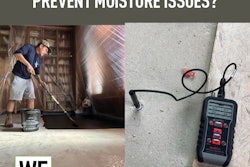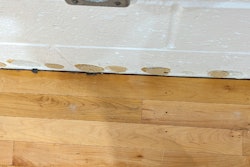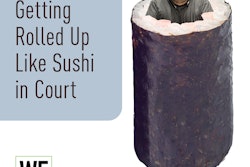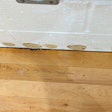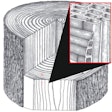One of the topics that causes the most confusion in the wood flooring industry is moisture in concrete and the tests used to measure it. A common question is, "Do calcium chloride and RH concrete tests measure the same thing?" The quick answer is no.
How CaCl Works
The calcium chloride (CaCl) test (ASTM-F1869) is intended to measure the moisture vapor emission rate (MVER) from concrete. But how does it work? CaCl is a chemical compound that attracts water; the water molecules become attached to the CaCl molecules. Once attached, they don't react to form a new molecule; instead, they just sit there hanging about together.
For the test, the CaCl, which has the greatest ability to attract water, has had all of the water removed from it by heating/baking it in an oven. The companies that make CaCl test kits take the totally dry CaCl crystals and seal them in a plastic dish to keep them dry until it is time to use them. The dish of dry CaCl is accurately weighed. On the job site it is placed under a clear plastic dome-shaped hood, which is sealed to the surface of the concrete. The dish is left in this position for 60 to 72 hours, after which the CaCl dish is immediately weighed. Any increase in weight is equal to the amount of water that was attracted to the CaCl. This change in weight is then used with the exact number of hours to compute the MVER, which is stated as "pounds of water per 1,000 square feet in a 24 hour period," which is generally abbreviated as "X pounds."
What CaCl Tells You
The wood flooring industry has generally come to the conclusion that 3 pounds MVER is acceptable for concrete that is to have a wood floor installed over it. When you get a high MVER result, you can be pretty certain that there is an excessive moisture problem. Depending on a low MVER from a CaCl test can be misleading, though. Since excessive moisture in concrete is always going to be the highest further down from the surface, anything that blocks the flow of water to the surface (like concrete curing compounds or over-troweled concrete) will give a lower MVER result than is actually present. Also, testing performed at the surface is susceptible to the temperature and RH in the air above the concrete.
The RH Test
The relative humidity (RH) test (ASTM-F2170) measures the RH below the surface of the concrete slab by using a hole that is typically drilled to a depth that is 40 percent of the slab thickness. On the job site, the hole is drilled slightly larger than the diameter of the cylindrical probe that will be used for the test. The hole is vacuumed and then sealed so that it is isolated from the air above the concrete. After waiting 24 hours or longer, a cylindrical probe is inserted into the hole, and readings are taken after it equilibrates. The testing instrument has specially designed temperature and RH sensors that are capable of measuring conditions inside the concrete.
What to Use?
RH testing in concrete was originally developed at the Portland Cement Association (PCA) in the 1950s by research scientists, and ASTM F2170 was first adopted in 2002. Calcium chloride (CaCl) testing has been the primary means of determining concrete moisture levels, however, the Portland Cement Association and concrete consultancy CTL have supported the new RH standard as a replacement for the CaCl test.
For further information, NWFA members can read "Concrete Slabs & Moisture Issues" by going to www.nwfa.org, clicking on "Services & Supplies," then "Business Publications," then "Concrete Moisture Study 2004."















